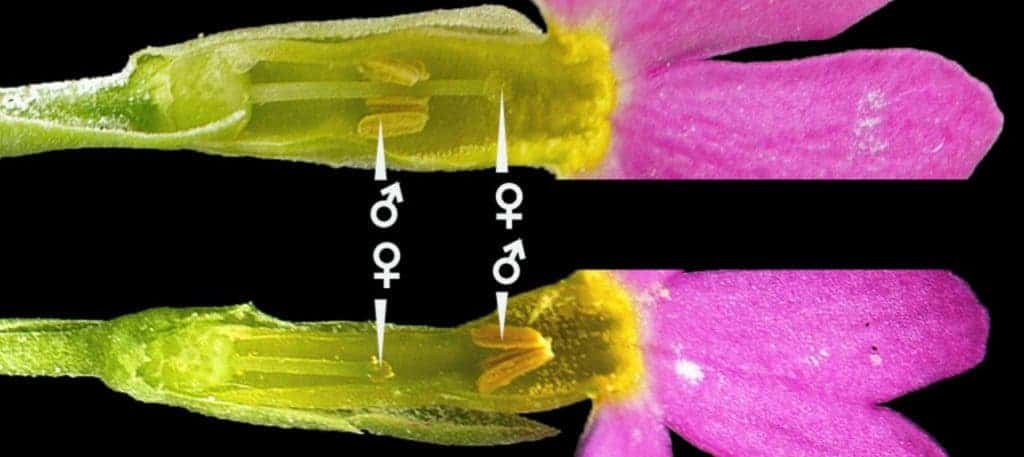
Heterostyly in Primula farinosa: the position of the stigma (♀) in each morph corresponds to the position of the anthers (♂) in the other morph. Credit: Royal Society
Herbalists, gardeners, and biologists have known since the 16th century that flowers come in distinct forms based on the position of the male and female sex organs. More than 150 years ago, Charles Darwin claimed that this phenomenon called “heterostyly” appeared to prevent pollinating insects from fertilizing flowers of the same type. This seems to be extremely important because, in the end, heterostyly leads to cross-pollination between unrelated plants and variation in the offspring – the fuel that powers natural selection.
It’s said Darwin thought heterostyly was the greatest and most fulfilling discovery of his career. Now, using modern tools, biologists have found the supergene or cluster of genes responsible for coding reproductive traits in the Primula flower which Darwin grew in his own back garden and used to experimentally validate his hypothesis.
The work led by researchers at University of East Anglia, UK, concludes that the two forms of flower, known as ‘pins’ (female stigma and style are greatly elongated, male anthers are shortened) and ‘thrums’ (the pins reverse — female parts shortened and male organs extended) are coded by genes that surfaced some 51.7 million years ago. These clusters of closely-associated genes are called supergenes because they act together as a unit and control complex biological mechanisms. The heterostyly supergene is called S locus.
“Not only did we identify the supergene but we found it is specific to just one of the flower forms, the thrum. This insight has profound implications for our understanding of a key evolutionary innovation of flowering plants,” said Prof Philip Gilmartin from UEA’s School of Biological Sciences.
“This study answers some of the crucial questions that have been asked since Darwin’s time, and for me since I bought my first packet of Primula seeds twenty years ago,” Gilmartin added.
Following the sequencing of the Primula genome, the researchers found that the supergene is related to another identified six years earlier which controls the identity of petals on a Primula flower. At some point this gene duplicated, inserted itself in the S locus, and mutated to control the position of the anther in the flower. Finding the duplicate gene proved to be important because it is this way that a mutation can be dated.
“Understanding of the genetics which underpin flower development and reproduction of a species broadens our knowledge about the entire system of pollination, which underpins biodiversity and food security,” noted Gilmartin about the study’s importance.
“With challenges such as climate change and its effects on plants, crops and their insect pollinators, it’s even more important to understand pollination mechanisms and how species can and will react.”









